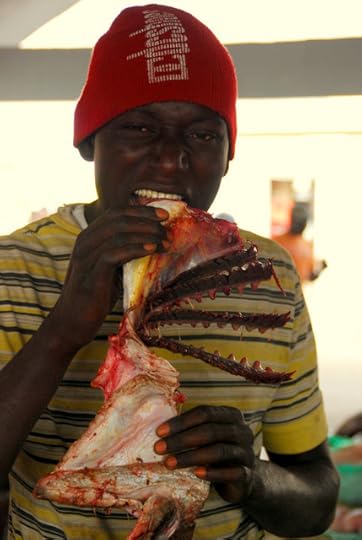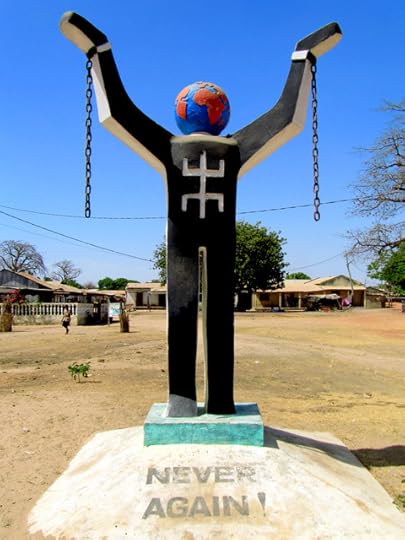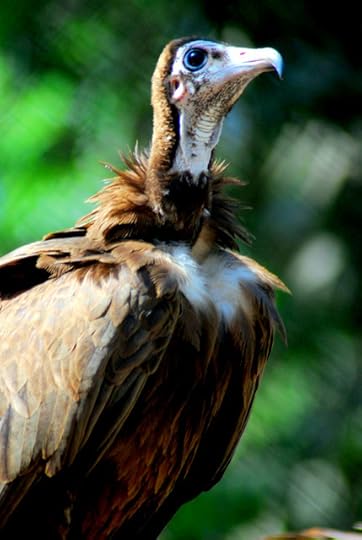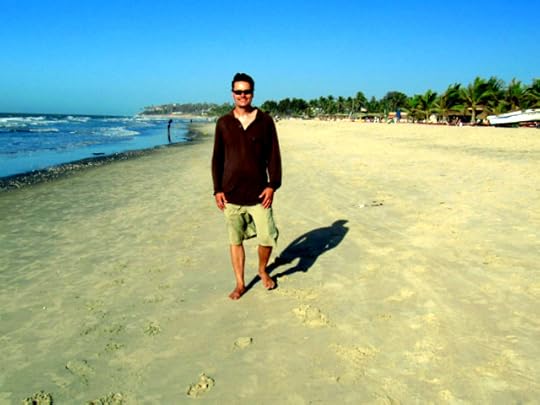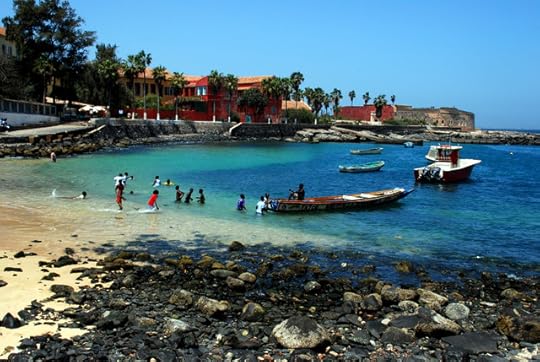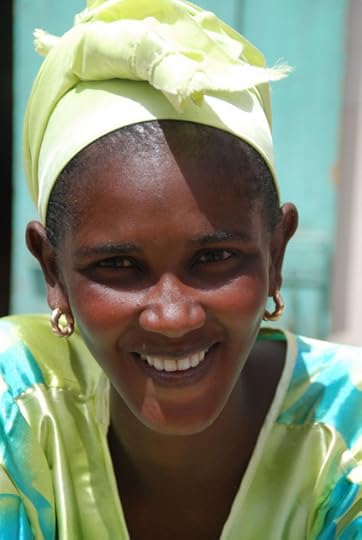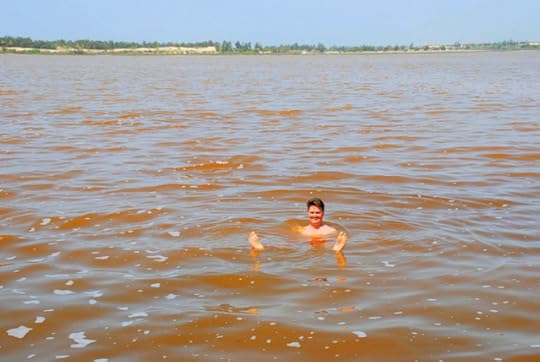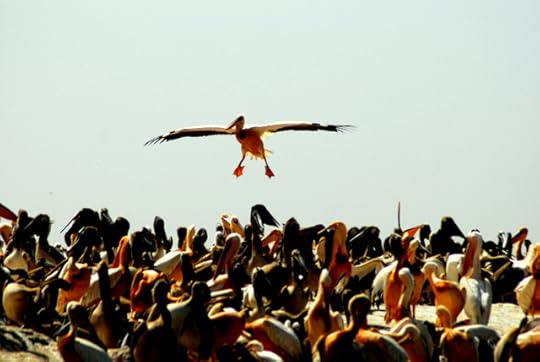Roderick Phillips's Blog, page 14
March 15, 2014
Fish market, Nouakchott, Day 230
I don’t know why I’m continually surprised to find an abundance of mosquitoes in these desert environs. Quite whether they are the death-dealing kind, I don’t know, but either way I don’t like them. The buzz of a single mosquito around my ears sends me into a panicked frenzy and I know I will not be able to sleep until one of us is dead. Consequently, I dueled with the insect world for most of last night; only it’s impossible to kill all the mosquitoes. You kill one and two more spring from god knows where. While I duel, Christi tries to block the access points of which there are many in this room. And I don’t want to hear a squeak about bringing your own mosquito net next time, because that is not going to help us now. Because of our nefarious nocturnal activities last night, we postpone our early morning visit to the fish market. I suppose it would have been fun to watch the fisherman launching their small boats into the Atlantic, but it will be equally fun I’m sure to watch them land their catches this afternoon.
Christi and I emerge from our room at mid-morning bearing an abundance of itchy welts on our skin, so I guess we didn’t win after all. The hotel manager, Isaac, is sympathetic and offers us a better room with a mosquito net – for an extra US$1o per night. I decline (Note looking back on these diaries, it is hard to escape the conclusion that sometimes I can be a little too stubborn. Don’t mention anything to Christi, though, because I’ve always denied this. Wait…what did I just say?).
We enjoy a fast-food schwarma lunch at a nearby restaurant that comes with a blindingly bright orange soft drink. Goodness knows what the locals add to their drinks to make them glow so orange, but whatever it is, I’m not drinking it. Later as the temperatures begin to dip from excruciatingly hot to simply unbearable we decide to visit the fish market. Finding a taxi that will take us there is another matter. None of them can believe we would want to go there and we receive yet more odd looks. Still, the Lonely Planet guide says it is one of the few interesting things to do in this desert city by the sea. And keeping busy stops us from thinking what we are going to do if Ahmed and Sheldon Cooper do not appear tomorrow.
The fish market is probably only a mile from our hotel, but already there is a sense of leaving the city behind. An impressive aircraft hangar-like building houses the market itself and there are some mighty fine, if completely unfamiliar fish, on display and there is much haggling over the catch. The fish market is located literally on the beach and when we can no longer bear the pungent aroma of entrails, we wander outside. The beach is frantic with activity as pirogues land their catch and the fish are quickly hauled away either on donkey and cart or by hand. There is a feeling of excitement and of community coming together. The people work hard, but they do so with a smile and the onshore breeze is divine. Away from the main action is a collection of huge creatures in shells squirming about in their death-throws. As much as we can figure they have been caught accidently and then discarded. I have no idea what they are – perhaps giant sea snails? It’s sad to see them struggling, but they are a little too creepy to touch.
Speaking of food, on our return to town we eat dinner at an authentic Chinese restaurant (although I keep away from the shell fish options). It never ceases to amaze me that you can find a Chinese restaurant in every city in the world. It wouldn’t surprise me if the first restaurant on the moon served Chinese food. We eat heartily in preparation for another vicious battle with the mosquito hordes tonight.
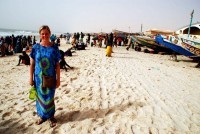

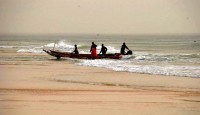
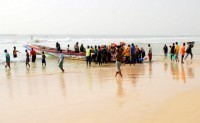
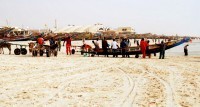
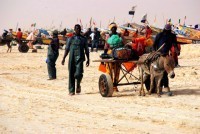
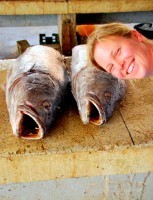
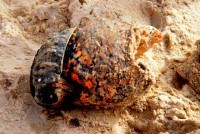
Blog post by Roderick Phillips, author of Weary Heart – a gut-wrenching tale of love and test tubes.
The post Fish market, Nouakchott, Day 230 appeared first on Roderick Phillips.
March 14, 2014
Nouakchott, Mauritania, Day 229
Although our flight from Banjul (Gambia) to Nouakchott (capital of Mauritania) is not until 10 am, we were told to be at the airport at 7 am. This necessitates an early morning (6:30 am) departure from our hotel. The random taxi driver I hired last night is a no-show. Bugger. Christi and I decide to wait until sunrise (about 7 am) and then flag down a taxi on the street. Miraculously our original taxi arrives at 7 am. The driver apologizes profusely, blaming the delay on a flat battery. Indeed he has to free-wheel his taxi down hill into the Leybato hotel to get the engine running.
We arrive to an empty airport. I mean there is no one around. The only Mauritania Airways flight to Nouakchott listed on the departure board leaves at 11:30 am (our ticket states 10 am) and it has a different flight number to the one on our tickets. What is going on? Have we been scammed again? An apologetic Mauritania Airways agent eventually appears and says the airport information monitors are all wrong. The flight, partially full, departs a respectable 30 minutes late. And it’s a ridiculously short 40-minute flight to Dakar (food and drinks served) compared to the 9-hours it took from Dakar to Fajara by public transport. We are asked to remain onboard because the new passengers will board immediately and we will depart soon thereafter.
That all sounds good, but the Dakar ground staff are clearly not paying attention as our luggage is removed from the hold of the plane and taken to baggage claim. I watch these events unfold with mounting alarm and jump out of my seat to confront a flight attendant. In my mediocre French and with much wild hand gesticulating, I convey that something is wrong. She finally gets the message and dashes off to retrieve our bags and I then have to go down on to the tarmac to confirm that indeed these are our bags. Can you imagine landing in Nouakchott without bags. The chances of us ever seeing them again would be zero. (Note, in November 2010 the airline was banned from European airspace by the European Commission due to persistant deficiencies in its operations and maintenance. The airline went out of business a month later. Gee what a surprise!)
Our 60-min flight to Nouakchott is quite impressive as we approach the city from the Sahara desert. A vast sandy expanse of nothingness eventually coalesces into a series of nondescript low-rise buildings and eventually the airport. Nouakchott does have a great, if little-known tag line: “Where the Sahara meets the Atlantic’. Christi and I are a little nervous as we de-plane, because we have been warned by the British Foreign Office and the US State Department not to come here as three Spanish aid workers have been kidnapped recently (Note one was released the day before we arrived, while the other two were not released until August of 2010 after a multi-million dollar ransom had been paid. Al Qaeda claimed responsibility for the kidnappings). Immigration formalities are straight forward, however, and taxi drivers are falling over themselves to help us. The loss of Western dollars and euros is clearly already biting in Mauritania. Our taxi driver has a tough time finding the cheap, crummy, flea-bitten hotel that we have picked at random from the Lonely Planet guide and eventually he drops us at the 4-star Tfeila hotel (formerly a Novotel). Of course we would like to stay here, but we simply don’t have the money to splurge at the moment. The staff helps us find something more in our price range (US$40 per night rather than US$180 per night for the cheapest room at Tfeila). Our hotel is called Maison d’hote (literally ‘Bed and Breakfast’). The room is rustic (i.e. negligible furniture) and comes with a ceiling fan and bathroom, but no mosquito net. The B&B is centrally located so we drop our bags and explore the area a little. We do receive quite a few curious stares and a few people stop to talk, but they are the most bizarre conversations. As we tramp around the exterior of the Mosquee Saudique (we’re not allowed in) with its grand minarets and exquisite carved geometric decoration we are approached by two men who say they are from the Gambian High Comission and wonder whether we want to purchase 6 kg of gold! We decline. Later another local approaches us asking where we are from. Nervously we reply Britain and America. It transpires he used to live in Kentucky with his brother who was killed in a bizarre work-related incident: he drowned in a vat of fermenting whisky!
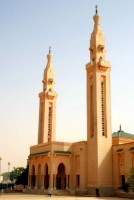
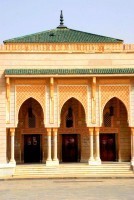
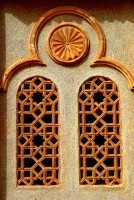
Blog post by Roderick Phillips, author of Weary Heart – a gut-wrenching tale of broken hearts and broken test tubes.
The post Nouakchott, Mauritania, Day 229 appeared first on Roderick Phillips.
March 13, 2014
Juffureh, The Gambia, Day 228
Our new fixer, Moore, fails to live up to his promise of securing flights to Nouakchott in Mauritania today. He takes us to the same travel agent that we visited on Saturday (and the staff categorically deny that Moore is the nephew of the owner). Our quote for the flight is D7,450 pp. Moore says with a straight face and no hint of embarrassment that D6500 is the local price; D7,450 is the tourist price. And much like Lamin before him, Moore seems surprised that we are not happy with his ‘help’. Christi and I had hoped to complete the purchase of airline tickets quickly today so that we could visit the village of Juffureh and James Island on the north shore of the Gambia River. Juffureh has a very famous connection to the slave trade that we wanted to explore. That trip is now in jeopardy. Instead we waste time approaching more travel agents. Moore, our wanna be fixer, will not leave us alone and offers to take us to Juffureh. ‘Take’ proves to mean he will accompany us on the taxi / ferry / taxi rides that will be necessary to reach this remote village. Moore eagerly explains how much the locals would pay the these trips, but that still does not endear him to us.
The next two travel agents quote us fares of D7,500 and D8,000 respectively. Neither of which are acceptable. We trudge despondently back to our hotel unsure how we are going to escape the suffocating grasp of The Gambia. Moore follows us, but at a safe distance until I tell him (none-too-politely either) to leave us alone. We pass one final travel agency and this time we tell the agent that the online fare is D6500 and could they, The Future Travel Agency, match that price. No worries, they say and quote us a fare of D6,250. I am rarely lost for words, but my mouth drops open. This is AMAZING. Of course I now have to obtain sufficient cash to pay for the tickets, which means taking D14,000 out of the Standard Chartered ATM. I try to remain calm, but I’m nervous as hell carrying so much money around in broad daylight. A nerve-racking wait ensues as the agent types a book-full of information into her computer, which is followed by a hollow silence rather than the comforting sound of tickets being printed. ‘We’re waiting for approval from the airline,’ she says unconcerned. Perhaps the airline realizes the fare is wrong and will not proceed with the sale. But no, the printer springs to life and spits out two ONE-WAY tickets to Mauritania. And there can’t be many people in the world who would be so happy with that arrangement, but Christi and I are ecstatic. Huge thanks to The Future Travel Agency for great service at a reasonable price.
It’s now 11am and I still want to visit Juffureh and James Island, but do we have enough time? In the end we go for it. It’s a 20-minute (D175) taxi-ride back to the ferry at Banjul followed by a frustrating 1-hour wait for the boat to unload and reload goods, vehicles and passengers. We pace the dockside like big cats waiting to pounce such is our eagerness (Christi says that is an unrealistic image. Her memory is that sat on a bench reading quite contentedly, while I was jumping up and down with increasing frustration. I like my version better). The ferry ride is 45 minutes, so we arrive in Barra at 1:15 pm. Naively we had believed Moore when he said that a taxi from Barra to Juffureh would take 30 minutes and cost no more D140. The taxi drivers all want D1000 to drive us there, wait while we explore, and then bring us back to the ferry. The negotiations go back and forth with numerous drivers; tempers rise; time passes. We walk away from the ferry to try our luck with a more sympathetic driver. We wake one young guy, Serem, from his lunch-time siesta and he reluctantly agrees to do it for D550.
The ride, in a thoroughly decrepit Ford Fiesta, is a brutal 1-hour slog over rough roads. We pass hundreds of school children, but see no schools and only a few villages. We finally pull into in a dusty, deserted village square located on the banks of the Gambia River. The river is so wide at this point that we cannot see the far shore, only a tiny, forlorn island in the distance. It’s now 3 pm. There are a few other tourists loitering about with the obligatory guide. As soon as we step out of the car guides descend upon us, but we decline their services much to their annoyance. Around the square is the Kunta Kinteh Roots Camp, a statue with broken chains stating ‘Never Again’, a welcome arch, a gun emplacement and a few derelict buildings. A small jetty is home to a few pirogues that make regular trips out to tiny James Island (Note now renamed Kunta Kinteh island). On the island are the ruins of a fort that was used as a holding facility for slaves before they were sent to Ile de Goree or Cape Coast ahead of their onward transport to The Americas. According to the author Alex Haley who wrote the novel, Roots, based on his own family history, this is where is ancestor, Kunta Kinteh, was enslaved.
As usual I’m not willing to meet the asking price of the pirogue captain for a ride out to James / Kunta Kinteh Island, but having already visited Cape Coast and Ile de Goree we have seen plenty of slave cells. What is more interesting is the local slave museum, which depicts yet more horrific details of the evil that man perpetrates on his fellow man. During the voyage to The Americas, the so-called Middle Passage, slaves were crammed together like factory-fed chickens, with no sanitation, little food, and literally suffocating conditions. Twenty percent of the slaves died on the crossing. It is estimated that over a 200-year period 750,000 slaves passed through James Island, 150,000 of which did not survive the Middle Passage.
We’ve saved the best for last. Not only for today, but for The Gambia, and our while disturbing experience with the slave trade. We visit the descendants of Kunta Kinteh who it is believed was captured by Portuguese Slave traders in 1767 at the tender age of 18 and transported to the USA. Oral history within the Kinteh family has kept this memory alive until eventually Alex Haley was able to track down his ancestors and current relatives. It took him many years and several visits to different parts of Africa to eventually find Juffureh in the Gambia. The result was of course the phenomenally successful (if somewhat contentious) book, Roots, which in 1977 also became a TV mini-series. Christi and I meet Mariama Fofana who is an 8th generation descendant of Kunta Kinteh and the matriarch of the Kinteh family. We listen to the Kinteh headman recount the oral history of the Kinteh family, which is both a sad and a magical experience. Christi and Christi and I never planned our Year of Wonder to coincide with the route of the nefarious slave trade between West Africa and The Americas, but from the mines of Potosi to the churches of Ouro Preto, and the slave cells of West Africa we have received a sobering education that we will never forget.
It’s another long journey back to Fajara and we arrive after dark. We eat dinner at the nearby expat hang-out Francisco’s , watching more English football, and then stumble back to our hotel in the dark (there’s negligible street lighting). Along the way I try to hire a taxi that will take us to the airport early tomorrow morning. I shake hands on a deal for D200 (The Future Travel Agents said the fare should be about D150; our hotel had wanted to charge us D500). A word to the wise: our hotel, The Leybato hotel and restaurant, routinely overcharged us for everything – or tried, at least. I’m not sorry to be leaving The Gambia.
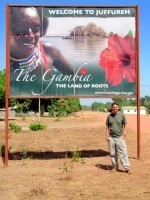


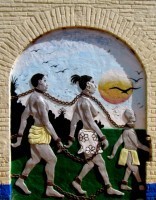
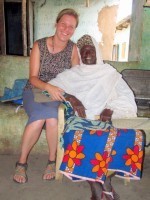
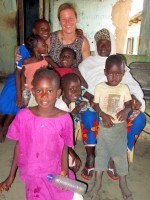
Blog post by Roderick Phillips, author of Weary Heart – a gut-wrenching tale of broken hearts and broken test tubes.
The post Juffureh, The Gambia, Day 228 appeared first on Roderick Phillips.
March 12, 2014
Abuko Nature Reserve, The Gambia, Day 227
According to the Lonely Planet Guide to West Africa, The Gambia is Africa for beginners. By which I assume they mean for the travelers, because the locals are experts at scamming money and charging inflated prices. The Gambia is a relatively short flight from Europe and being an English-speaking nation is quite popular with British people who wish to sample the forbidden delights of Africa without enduring the hardship. Indeed, The Gambia is becoming an attractive retirement destination as the cost of living is undeniably less than Britain. Equally, The Gambia a relatively cheap holiday destination for Western tourists and they appear happy to pay whatever prices the locals charge – even when those prices are much higher than other Gambians might be asked to pay for the same item or service. I fully admit that I may be alone in believing that it should be the same price for all. I mean it’s not as if visitors to Britain or America pay twice as much as a local for a meal or a hotel room. There again The Gambians may think it is good business to ask as much as possible for something and if the tourist will pay then why not? I don’t have a good answer for that, but when Christi and I try to bargain hereabouts the locals are surprised and become quite stubborn. I mention this, now, dear reader, because our tour today (of Serrukunda market, Abuko Nature Reserve, and the coastal waterways) left me cold and indignant. Which is pretty much what I think of The Gambia in general. I didn’t come here thinking I would dislike the place, but of all the countries I have visited in Africa (and the total to date is 21) The Gambia is my least favorite.
The guide assigned to us by our hotel is called Lamin. I’m not sure if he works for the hotel or if the tour is sub-contracted. The tour begins pleasantly enough at the Serrukunda market. It’s a typical West African market and we have seen plenty over the last 6 weeks, so perhaps we are less impressed than the typical tourist. We move on swiftly, which is one of those rare occasions where the time allotted by the tour guide is too much. Next up is the Abuko Nature Reserve. Even though the tour is costing us D1500 (US$60), the D35 entrance fee is, surprisingly, not included. Lamin leads us along a series of marked trails through dry, dense foliage and forests. We spot a red colobus monkey and later a did-dik (small antelope). We stop in the shade at a watering hole,which supposedly is home to Nile crocodiles, although we did not see any. There were a variety of herons, kingfishers, and other wading birds present (the park is notable for its bird life) and a monitor lizard. Again, we are underwhelmed. Mole National Park and Niokolo Koba National Park were infinitely better and don’t forget Christi and I have been on safari in East Africa, which is about as good as it gets. The Abuko Nature Reserve is more like a city park that just happens to have a dwindling amount of wildlife living there.
In the center of the reserve is a small zoo, which is home to a troop of friendly baboons who quickly snatch the proffered nuts (courtesy of Lamin) and red colobus monkeys. The caged hyenas are a fairly emasculated group, although the wood vultures that gather to partake in the carrion feast doled out by the zoo attendants are at least wild. Lamin says the zoo did have a lion at one point, but he escaped and was shot by the army! It ‘s another hot day in The Gambia (even though we’re here in March. I can’t imagine how unpleasant West Africa would be in the heat of summer) so we stop at the zoo cafe for a cold drink and being the nice people we are buy one for Lamin as well. Leaving the park is a bit like exiting a ride at Disneyland: you have to negotiate the souvenir shop first. And yet again the locals engage in the hard sell, but Christi and I are equally defiant in our desire not to buy anything (mostly because we’d have to carry the crap around Africa until we could think of some way to ship it all home without it getting broken along the way).
Our final destination is Lamin Lodge and our 2-hour cruise around the mangroves. This is where things really begin to go wrong. Preceding the boat trip we are given a mini village tour, which is actually quite fascinating. We are told that oysters and cockles are collected from the mangroves at low tide by the women of the village. The oysters actually attach themselves to the roots of the mangroves and the women cut them free. By the time we arrive the women of the village are shelling the oysters and cockles for eventual sale to nearby restaurants. The shells are not wasted, though. First they are dried and then burned to a white ash. When this ash is combined with sand it forms cement; when combined with water it forms white paint. The addition of different dyes can give a variety of colors. Alternatively, the dried shells can be crushed and sold to chicken farmers. The crushed shells are added to the chicken feed and provide a good source of calcium. So far so good. The next thing we know, though, the village guide wants a donation to the local village blind school. This is a blatant scam. We are very disappointed with Lamin who (despite being a guide for 12 years and a resident of the village) says he did not know we would be asked to make a donation after this tour. Christi and I only toured the damn village to be polite. Clearly Lamin is being economical with the truth. Lamin quickly makes a donation and hustles us away to a boat. He’s arranged an upgrade he says. So instead of a gentle 2-hour paddle thorough the mangroves and an opportunity to spot wildlife and watch the world go by, we get a 1-hour power-boat ride that zooms around the mangroves causing mayhem. Christi and I are not impressed.
As I mentioned before one possible option for our time in The Gambia was a cruise upstream possibly as far as James Island which the Ile de Goree and Cape Coast Castle equivalent. Lamin says he will take us tomorrow for only D3,500 (US$130). Lamin Lodge appears to offer boat rides (via a pirogue) to James Island. Lamin assures us that to go by pirogue would be D7,000 (US$260). I’m skeptical of everything he says, but before I can confirm or even negotiate a price with the owner of the pirogue, Lamin dashes ahead and has a rapid conversation in the local Wolof language. Whatever the price might have been, the owner of the boat now assures us it is D7,000. I am furious with Lamin, who genuinely appears shocked. We return to our hotel in silence. Lamin then has the nerve to ask about hiring him tomorrow to guide us to James Island and waits for a tip for today’s outing. He waits in vain.
Still, one is not alone for long in The Gambia and nother ‘fixer’ wannabe called Moore hangs around the entrance to our hotel compound (he’s not allowed in the grounds) wanting to talk to us. Somehow he knows we want tickets to Nouakchott for the day after tomorrow. He says his uncle runs a travel agents and the price per ticket is D6,500 (US$240) which is a great deal. If you recall it was US$190pp just to get to Dakar. We agree to meet him tomorrow to buy the tickets. He adds that he can also help with transport to James Island (how did he know we wanted to go there as well?). Perhaps things are looking up.
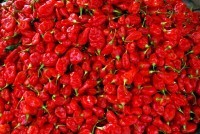
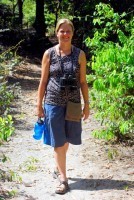
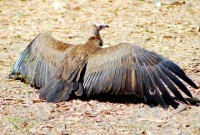
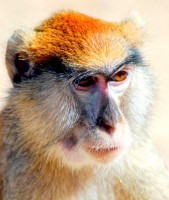
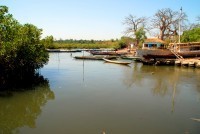
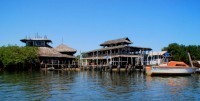
Blog post by Roderick Phillips, author of Weary Heart - a gut-wrenching tale of broken hearts and broken test tubes.
The post Abuko Nature Reserve, The Gambia, Day 227 appeared first on Roderick Phillips.
March 11, 2014
Fajara, The Gambia, Day 226
The hotel is quick to rustle up a mosquito net this morning and promises to spray the room, although this begs the question: why did we even have to ask? Christi and I came to The Gambia on a whim. We had a few days to kill while Sheldon Cooper completes a pre-arranged trip to the Cape Verde Islands. We’ve agreed to meet him in Saint Louis in 5 days and continue overland to the border town of Rosso where Ahmed the Finger will meet us and guide us through Mauritania. Christi and I chose to collect another country rather than stay in Dakar. Now that we’re in Fajara in The Gambia we have no idea what to do or how to get back to Saint Louis. Christi and I had had the romantic notion of taking a boat cruise up The Gambia River (our cruises through the Galapagos Islands and Tierra del Fuego and then down the Amazon River had somewhat convinced us that we liked atypical boat trips). Even though The Gambia is tiny we realistically don’t have time or indeed the money to do this type of journey and get to Saint Louis in the required time, although to be honest neither Christi or I can bear the thought of 1.5 days in a various forms of unpleasant public transport to get from Fajara to Saint Louis. So we’re stuck and now we have to extricate ourselves from the mess we’ve created.
Turns out that’s easier said than done. Fajara, indeed, the whole country shuts down for one Saturday morning a month for National Cleaning Day. And that day, unfortunately, is today. Supposedly, all the trash is removed from the streets. Supposedly. Businesses see little point in opening for a few hours in the afternoon so Fajara is largely deserted for the whole day. Therefore gaining any information that might help get to Saint Louis and explore something of The Gambia in the time we have available to us is virtually impossible to come by. We walk along the main drag, Kairaba Avenue, in ferocious heat staring at a lot of closed doors. We do manage eventually to take D4,000 (US$150) out of an ATM at Standard Chartered bank and identify potentially useful shops if they ever open. Tired, hungry, and grumpy we find lunch at a reasonably pleasant restaurant called Franciscos, which is an expat hang-out that is showing live English soccer. This cheers me up no end.
Later in the afternoon we do find a travel agency that is open and inquire about flights to Saint Louis. There are precisely zero. How can this be when Saint Louis is the second city of Senegal? We can get a flight to Dakar on Wednesday afternoon for US$190pp, but then we’d never make it to Saint Louis in time to meet Sheldon Cooper. We retire to an internet cafe and confirm no flights exists to Saint Louis. Christi then has the brilliant idea of flying to Nouakchott, capital of Mauritania, directly and there is a flight on Tuesday with Air Mauritania. Sod’s law we can’t book this flight online so we race back to the travel agents which is now closed until Monday morning.
Dejected we return to our hotel and organize a tour of the area for tomorrow. We know we’re being ripped off on the price, but we have no other option if we actually want to see anything of this country in a short space of time. Our hotel is right on the beach and we decide to go for a relaxing walk. No such luck. Although the beach is quite fetching with its golden sand, palm trees, and cafes (including one named Kunta Kinteh – more on that story in a couple of days), the peddlers and hawkers that bothered us in Fajara during the day have multiplied and taken over the beach. We are pestered continually. It is nothing like the peaceful experience of Brenu beach in Ghana. So far The Gambia has been an unpleasant hassle.
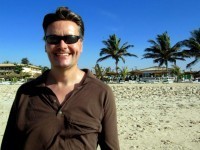
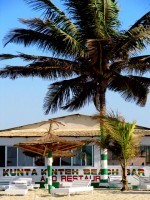
Blog post by Roderick Phillips, author of Weary Heart – a gut-wrenching tale of broken hearts and broken test tubes.
The post Fajara, The Gambia, Day 226 appeared first on Roderick Phillips.
March 10, 2014
The Gambia, Day 225
The Gambia is the smallest country in continental Africa and is completely surrounded by Senegal, except for where the Gambia River empties into the Atlantic ocean. The Gambia is literally a narrow strip of land either side of the Gambia River, stretching from the ocean 100 miles inland. This country owes its existence to the slave trade and the colonial powers. Britain and France divided this part of West Africa such that the French gained control of the Senegal River and Britain got the Gambia River. Indeed, The Gambia only attained independence from Britain in 1965. One consequence of the colonial period is that The Gambia (in common with Ghana) are English-speaking nations, whereas Mali and Senegal are French-speaking.
If there are comfortable air-conditioned buses between Dakar (in Senegal) and the border town of Karang to the south, then the owner-drivers of the cars and minivans at Gare Pompiers do not share that gem of information with Christi and I and the chef de gare (station master) is nowhere to be found. Not for the first time Christi and I are the only white folks present at a bus station and not for the last time I’m sure we are completely clueless. We attract a lot of attention; the locals are eager to know our destination. When we finally reveal all, half-a-dozen arms try to pull us in 6 different directions simultaneously.
We eventually land in front of a decrepit Peugeot 504 estate wagon that has been modified to accommodate two rows of three seats in the rear. Which is fine if you are a midget, but I’m closer to six-feet tall. This type of ride is called a ‘sept-place’, which is French for 7 seats (8 including the driver). There are of course no such thing as safe driving practices only the practical concern of how many people can you fit into the car. The ticket is CFA5,500 (US$11) per person, but then the driver wants to charge another CFA5,500 for each bag. I shake my head vigorously and we attempt to leave the scene. Several hands restrain us and the negotiations begin. We finally compromise on a total price of CFA15,000 (US$30) for the luggage and Christi and I. For an additional two bucks I could have enjoyed all the comforts of the front seat to myself. I’m either too cheap or too principled, but I decline. On reflection that was a very bad idea. The front seat is snapped up by the seventh passenger and we’re off on a 5-hour jaunt to the border.
Only our ‘sept place’ doesn’t have 7 passengers; it has 9. I get the middle seat in the back row sandwiched between a woman and her two children on one side of me and another lady who insists on traveling with several large bags by her side rather than tying them onto the roof rack and Christi and I had done. Amazingly the children were very well-behaved; partly because the mother constantly breast-fed her daughter (about 3) while the older boy (about 6) stood between her legs for the whole journey and used my thigh as a pillow. Myself and the two women sat hip-to-hip and shoulder-to-shoulder. Most of the time one adult sat forward to provide a little extra breathing space for the other two of us. Initially my legs were tucked up under my chin, but after a painful hour I forced my legs down either side of the central divide, much to the annoyance of the two women. Perhaps the journey would have been marginally less painful without the children and the bags, but as it is I’m squashed into a space only large enough for someone half my size. Christi fares a little better in the row of seats ahead of me, although she is squashed between two men, who are no doubt enjoying the close contact. We leave Gare Pompiers at 8:30 am and barely stop over the next 6 hours. Exiting Dakar is a nightmare; the congestion remains unbelievable. Eventually, though, the urban sprawl gives way to more rural scenery where only larger, slower vehicles and village traffic delay our progress. The further south we go, the worse the roads become, while the temperature and conditions within the Peugeot become increasingly intolerable. I have little interest in communicating with my fellow travelers under such conditions; it’s all about enduring and surviving the chronic discomfort.
At about 2:15 pm we finally reach a barricaded busy road in Karang that marks the end of Senegal and the beginning of The Gambia. Standing and stretching is a pleasure beyond my wildest dreams although my cramped arms and legs do rebel initially. Before we enter The Gambia I change US$100 into Delasi, the local currency. The exchange rate is very fair at US$1:D27, while the money-changer is drop-dead gorgeous (not that that was the reason I chose to change money with her, you understand). My US$100 should give me D2700. I watch the lady count out 27 D100 bills. I mean I’m inches away from the action and yet later I realize she palmed D600 (or about US$25). I’m actually so impressed by her scam that for once the money issue does not bother me. Clearly that woman is wasting her talents on such petty crime.
Next we have to negotiate the chaotic scenes in the immigration offices to exit Senegal (which are actually fairly easy) and those to enter The Gambia. The Gambian officials are much more thorough and hand check all our bags before grudgingly stamping our passports and permitting us to enter their country. We continue our tedious journey by taxi. It’s D300 (US$11) from Karang to the ferry at the town of Barra at the mouth of the Gambia River. The Gambia is literally bisected in two for its whole length by the eponymous river and the ferry at Barra is one of the key crossing points – when it works. Today, thank goodness, the ferry is running more or less to schedule. It’s D10 per person for the 45-minute ferry ride. Cars and trucks load first followed by passengers. For some reason (perhaps because we appear so destitute now) Christi and I are allowed to board with the vehicles and we watch the almighty scramble of passengers as they dash onto the boat. Getting off the ferry in Banjul, capital of The Gambia, is equally perilous and we are relieved to collapse into another taxi for the 30-minute D250 ride to the Leybato hotel and restaurant in the coastal suburb of Fajara.
The Leybato hotel is at the end of the road with a bar and restaurant overlooking the Atlantic ocean. It’s an average sort of place; nothing fancy, but the fact that we can stretch out on a bed that isn’t moving or take a dip in the ocean is wonderful. A room with air-con is D900 (US$33) per night, which we pay in advance. It’s only after we have paid that we are told there is no power at the moment (hence no A/C or light). We even have to ask the hotel staff for candles. We do have a profusion of mosquitoes, however, and a wholly inadequate net around the bed, and the little blood-sucking bastards keep us awake most of the night. We kill a lot, but they bite us plenty. It is an appropriate end to a miserable day.
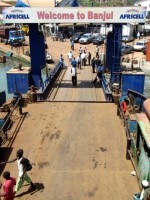
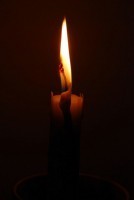
Blog post by Roderick Phillips, author of Weary Heart – a gut-wrenching tale of broken hearts and broken test tubes.
The post The Gambia, Day 225 appeared first on Roderick Phillips.
March 9, 2014
Ile de Goree, Senegal, Day 224
This is our last day in Dakar. The capital, itself, is not rich in tourist attractions, although it’s relatively easy-going and relaxed in comparison with the other West African capitals we’ve visited and the food is simply the best in the region. Dakar does, however, have a major tourist attraction right on its doorstep, Ile de Goree.
Despite its small size (Goree is 900m long and 300m wide, covers 2.7 hectares, and is home to only 1500 permanent residents), the island is an absolute gem; an undisputed highlight of West Africa. Goree is famous, or infamous, for being another prominent slave center; the Cape Coast equivalent of Senegal. We immediately acquire a guide named The Lion (although judging by his crutches and scars he lost more battles than he won), but he has a fair few tales to tell. Some of them may even be true. We learn that Goree is a UNESCO World heritage site and a US$1 tourist tax is levied on each visitor to keep the place clean and tidy. The policy is clearly working as Goree is undoubtedly the cleanest place we’ve visited in West Africa.
Goree is actually an extinct volcano and we walk up a steep path for views over the island and back to the main land. There are also some quite precipitous cliffs on the far side of the island, which appears to be the final resting place of all the collected trash. As the trade in slaves declined in the late eighteenth century, Goree converted to legitimate commerce. The French also heavily fortified the island with huge gun emplacements and bunkers to protect not only Goree, but its interests in West Africa generally. These days the bunkers have been taken over by artists as galleries and homes. There is also a large abstract statue in the shape of a boat to commemorate the black diaspora. Goree is, despite the deluge of visitors, a very calm place to explore full of sandy alleyways, colonial buildings, and contemplative gardens. At least, it is now.
During the height of the slave trade many of the buildings on the island were used as holding cells. These days only one remains, the Maison des Esclaves, a museum and grim reminder of the evil that men do. The stories told to us by The Lion parallel those we heard in Ghana. Slaves were only allowed out of their cells for one hour each day for exercise and to use the bathroom. Apparently on Goree male prisoners were weighed and had to be above 60 kg before they could be shipped out to the Americas on the so-called Middle Passage. Those that didn’t meet the weight requirements were actually fed and exercised to build them up. Perhaps the most prized group of slaves were the young (very young) virgin girls. Often times these girls were raped by their European captors, although in the event that the girls became pregnant the resulting mulatto offspring were considered to be European and thus the children and the mothers were given a much easier life. The remaining, ‘less fortunate’ slaves were shipped off to The Americas through the Gate of No Return, although some of the chained prisoners wriggled free and jumped to their deaths in the water below rather than face the grueling voyage and a miserable life in the New World.
When not describing the myriad acts of debauchery and terror perpetrated on the enslaved Africans of Goree, The Lion ensures, quite effortlessly it has to be said, that Christi and I visit every tourist shop on the island. And there are a lot. For once, though, the souvenirs actually look unique and interesting and Christi and I finally weaken (Christi says I weaken, she is steadfast in her desire not to buy gaudy trinkets. This is actually a bit rich coming from her because on our first visit to Africa she bought all the gaudy trinkets she could find. Perhaps she’s learned her lesson). In the end we purchase a piece of sand art (multi-colored sand stuck to a wooden board). It’s a scene depicting rural life (CFA 10,000; US$20). I was also tempted by another piece as well, a quite stunning portrait of a nubile nude, but Christi refused to let me buy it! Apparently there is a difference between art and pornography.
Back at the harbour we pay The Lion CFA 4,000 for the tour and then settle down to a pleasant lunch overlooking the port. It’s a beautiful location with a small beach, laughing children, and clear aquamarine waters, surrounding buildings of faded pastel yellows and reds.
We return to Dakar later in the day to pack and say our goodbyes to those of the Dragoman tour group that are still in town, including Agatha Christie, John Malkovich, and Sinead O’Connor. Tomorrow we leave the capital and with a few days to kill before our rendezvous with Sheldon Cooper and Ahmed the Finger at the Mauritanian border, Christi and I are going to collect another country; the smallest country in Africa, in fact, The Gambia. This is a spontaneous decision and we don’t really know what we’re doing, but what could go wrong in just a few days? Famous last words.
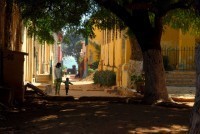
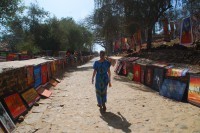
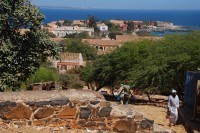
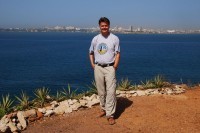
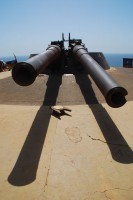


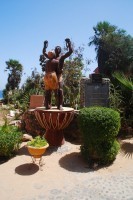
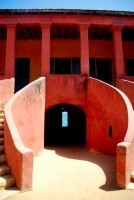
Blog post by Roderick Phillips, author of Weary Heart a gut-wrenching tale of broken hearts and shattered test tubes.
The post Ile de Goree, Senegal, Day 224 appeared first on Roderick Phillips.
March 8, 2014
Dakar, Senegal, Day 223
Not being part of the Dragoman tour any longer is something of a relief, but Christi and I still do not get to enjoy the lazy morning in our comfortable hotel in Dakar that we had anticipated. Sheldon Cooper sees to that. He calls our room at 8.15 am asking if we had seen the note he left for us in reception suggesting we meet at 8 am this morning? Clearly not! We tumble into reception 15 minutes later bleary-eyed and barely washed. Now that Sheldon has decided to join our trip to Mauritania, he’s attempting to run the show his way. The fact that he can speak French, has a cell phone and has already made contact with Ahmed the Finger does unfortunately give him a significant edge. Still, he can’t afford to completely upset Christi and I because we’re paying 800 euros to his 400 euros. Being a smart-ass McKinsey consultant, Sheldon knows this and to compensate us for our unexpectedly early morning he brings us chocolate croissants from a nearby patisserie. Well played, Mr. Cooper. Mr. Cooper also knows the way to the Mauritanian embassy and Christi and I meekly follow him into a taxi.
Visa formalities are actually a breeze. Security is minimal, the staff are pleasant and Christi and I are quickly and efficiently relieved of US$80 each for our 3-month single entry visas (which will be available after 3.30 pm today. Too easy). At this point we bid Sheldon goodbye, although he insists we meet back at the hotel at 3 pm so that we can all go to the embassy together. It’s easier to agree than to come up with a different plan, but that still leaves most of the day to explore Dakar and conduct a few chores. Our chores include the usual practice of uploading photos to Picasa and tentatively planning more adventures in Africa. Dakar, at least the part in which we find ourselves, has some very pleasant patisseries, a legacy of being a former French colony. I hadn’t expected to eat such tasty croissants, while the chocolates are sublime works of art – the best we have eaten since those far of days in Bariloche, Argentina.
Sheldon Cooper is, of course waiting for Christi and I as we stumble into the hotel Al Baraka a few minutes late. We feel like naughty school children in front of the headmaster! We taxi to the Mauritanian embassy where our passports are returned to us without issue (always a nervous time) and we are now the proud owners of quite decorative Mauritanian visas – and not many people can say that.
Head out to dinner without our constant shadow, Sheldon, at the nearby Senegalese restaurant, Keur Ndeye. We tuck into some local dishes, including chicken in maafe (groundnut stew) and Tieboudienne (fish, rice, and tomato sauce) while listening to live kora music. At a separate table Adonis and Aphrodite are enjoying their own romantic dinner. As the tour ended Agatha Christie asked Aphrodite what the future held for her and the nomadic Adonis. Whatever Aphrodite thought, she didn’t share them with us nosy folks, but the truth proved to be a difficult period for both of them. Happily, though, the beautiful people have finally taken the plunge and are now engaged. So good luck for a long and blissful life together.
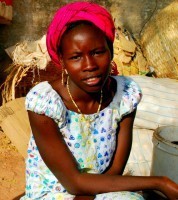


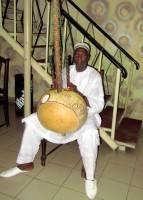
Blog post by Roderick Phillips, author of Weary Heart, a gut-wrenching tale of broken hearts and broken test tubes.
The post Dakar, Senegal, Day 223 appeared first on Roderick Phillips.
March 7, 2014
Lac Rose, Senegal, Day 222
Although tomorrow is technically the last day of the trip we will be in Dakar tonight and free to do as we please. My last night under canvass for a long, long time ends at the ungodly hour at 5:30 am. Louise and I make the last breakfast for the group (a mish-mash of porridge, fruit, and ravioli with toast), while Christi breaks down the tent and packs our stuff away. Everyone mucks in for the last chore of cleaning the truck (it is filthy), sorting through the boxes, and basically ensuring we have not lost anything. Adonis and PeeWee will begin another tour in reverse in a few days, all the way back to Cameroon and Nigeria. There is an end of term / semester feeling as we board the truck one last time. Our last adventure before we reach Dakar, capital of Senegal, is a visit to Lac Rose.
Lac Rose (Rose Lake) is so-named because the minerals and salts present in the water that give the lake a pinkish hue. It is (or was) also the finish of the Paris – Dakar rally. Although because of the previous safety concerns in Mauritania, the most recent edition of The Dakar as it is now known was actually run in Chile and Argentina (and continues so to this day). The rally is dangerous with many drivers being killed over the years, not to mention locals (including children). In 1982, the son of former British Prime Minister Margaret Thatcher, Mark Thatcher, went missing during the rally, but a massive search and rescue mission found him and his colleagues before they perished. Thank goodness for a famous Mum.
Unfortunately we take the slow bumpy side roads to the lake, which takes 6 long hours. Our stopping point is at Niwa oasis camp site. The lake is as much about industry as tourism, with salt extraction being an important business. The lake is not immediately appealing; there’s a salty scum at the water’s edge plus an abundance of rubbish, not to mention some aggressive hawkers patrolling the lakeside. The camp site, on the hand, offers a clean, refreshing pool and a delightful menu. I eat a rather tasty spicy chicken for lunch.
Just before we leave, I relent and take a dip, really a float, in Lac Rose. Much like the Dead Sea, the water is so salty that bathers actually float. (Note diving into either body of water results in salt in the eyes, which is rather unpleasant. The salt also penetrates any cuts or grazes and stings like crazy. Be warned!). The water in Lac Rose has an unpleasant, slimy feel to it, so after the briefest of paddles, I return to the camp site pool for a cleansing dip.
Although Lac Rose is only 40 km from Dakar, Adonis warns us that the congestion is brutal. I nap mostly, leaving Adonis the unlamented task of weaving the massive Dragoman truck between pollution-belching lorries and minibuses, horse and carts, herds of domestic animals, and the locals, not to mention the very narrow streets of Dakar. In fact, we completely block the street outside of our hotel (the quite lovely Al Baraka, which is undoubtedly the best of the entire trip) while John Malkovich, Doogie Howser, and I toss bags off the truck for the last time. Yippee!
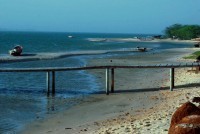
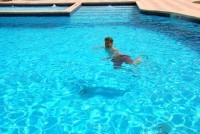
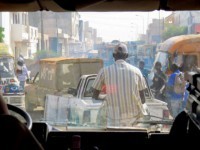
Blog Post by Roderick Phillips, author of Weary Heart – a gut-wrenching tale of broken hearts and broken test tubes.
The post Lac Rose, Senegal, Day 222 appeared first on Roderick Phillips.
March 6, 2014
Parc National des Oiseaux du Djoudj, Day 221
Group dynamics hit a tour low last night. Having ‘done’ Saint Louis yesterday no one feels inclined to return there today. We could just hang out at the Zebrabar camp ground, but most of us would prefer to continue exploring Senegal. It had taken a unanimous vote of approval from the group to make the changes to the itinerary that brought us to Saint Louis in the first place. Now a vocal minority of one has decided to block further amendments because she is unhappy with the lack of special treatment she has received during the trip. She argues to return to Saint Louis – not because she is enthralled with the city (it is after all full of children) – but because the alternative option is to visit Parc National des Oiseaux du Djoudj, one of the premier breeding grounds for birds in the world. Only an acknowledgement of the veto power she wields and a promise to be more considerate towards her, especially around her dietary requirements, elicits the necessary agreement to play nicely with the rest of the group.
We leave for Parc National des Oiseaux du Djoudj, therefore, with a combined sour taste in our mouths, but at least we are going. And it is a place that Adonis has never been to before so it will be an adventure for him too. Finding the place is fairly adventurous in itself as there are few signs and the roads are a pot-holed mes. Thank goodness PeeWee Herman is not driving because he is an expert at finding every hole. Adonis prefers to drive around them.
Although we’re visiting such a remote place, it’s well-known to die-hard bird watchers the world over and plenty of them are present because it is the pelican breeding season. The best way to explore the waterways that dominate the park is by pirogue. We hire two and there is a mad dash to secure seats in the pirogue that doesn’t include she who must be tolerated. I literally pull PeeWee Herman out of the right pirogue to create space for Christi and I. He looks crestfallen, but hey, taking one for the team is his job. There is a noticeable groan among the people in the wrong pirogue. The right pirogue zooms off amid happy, smiling faces. It’s not hard to guess who has the best experience in Parc National des Oiseaux du Djoudj.
There is an abundance of ducks, herons, cormorants and the like, but the most truly remarkable sight is the Great White pelican breeding grounds. I have never seen so many pelicans in one place before. The mature pelicans are yellow-billed, while those of a uniform darker color are immature. Our guide is very accommodating and unlike the wrong pirogue we don’t rush and we’re out on the water twice as long. In addition to the bird life we see several crocodiles, monitor lizards, and the always adorable warthogs. What an incredible experience.
Long slog back to our campsite, whereupon everyone not making dinner (that is, me and Louise) run to the bar. Christi and Thelma return early holding cold beers to at least provide some moral support. Louise and I are cooking spaghetti bolognaise; Christi tastes it and suggests adding more salt. She who must be tolerated expressly forbids salt in the food because of a health condition she may or may not have. As salt goes into the pot what no one realizes is that she who must be tolerated is hiding in the truck and spying on the cook group. Christi has the misfortune of entering the truck at the wrong moment and receiving the full wrath of she who must be tolerated. A pushing match ensues (my cook groups are cursed) before she who must be tolerated tumbles out of the truck. Go Christi! The spag bog at least goes over well with the rest of the group who are all disappointed to have missed the girl-on-girl fighting.

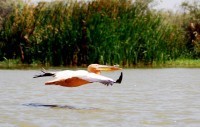
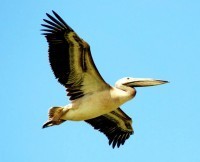
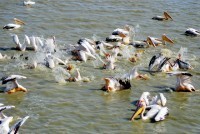
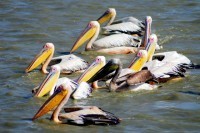
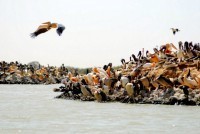

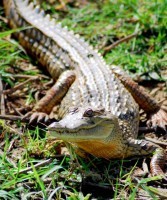
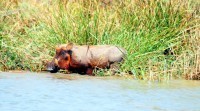
Blog post by Roderick Phillips, author of Weary Heart – a gut-wrenching tale of broken hearts and broken test tubes.
The post Parc National des Oiseaux du Djoudj, Day 221 appeared first on Roderick Phillips.

